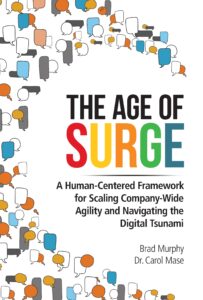The Age of Surge
What do Netflix, Spotify, and Google have in common? They all learn, innovate, and continuously adapt better, faster, and cheaper than traditional companies. Moreover, they use digital technology to innovate, disrupt, and grow in radical and dynamic ways. That’s how they surge ahead of traditional companies.
In THE AGE OF SURGE: A Human Centered Framework for Scaling Company Wide Agility and Navigating the Tsunami of Digital, organizational experts Brad Murphy and Carol Mase show how companies can leapfrog the competition by transforming not only how they develop products and services but also the organization itself around the digital paradigm.
How to Use Surge to Your Advantage
What is “Surge” and how do you use it?
SURGE is a framework that provides the tools for navigating complex adaptive challenges in large corporate businesses. The digital marketplace continues to be highly disruptive to the ways that companies engage with customers, innovate, and remain relevant. The traditional approach to navigating disruptive change has been to seek out a prescriptive formula and apply it to the whole company. The journey of transforming to a digital enterprise, however, is not a process upgrade or best practice adoption problem.
In our work with large companies, what we saw as a consistent point of failure is them seeking a paint-by-numbers formula—agile process frameworks being a classic example. Despite making significant financial and organizational investments, they’re still not producing the customer experiences we expect from digital native companies like Amazon, Netflix and Google. We saw a clear need to help leaders recognize that this is a journey, not a reboot. Digital has changed the dynamics of the marketplace forever.
How do traditional companies versus digital native companies differ when they view impending change?
The most profound difference is that digital native companies are designed for change. Traditional companies are not. If you are Amazon or Google, one of the fundamental principles is that the space you are seeking to deliver products and services into is subject to continuous change. Therefore, the organization itself needs to be competent in enabling this change to occur. Companies can no longer accurately predict the future. They must learn to co-create products and services with their customers by evolving rapidly with them.
Contrast that with most traditional companies that have built a legacy based on a physical experience. Banks have branches, car companies have manufacturing plants, retail stores have buildings. Physical things take a long time to plan, build, and establish. As consumer preferences have increasingly shifted to adopting digital platforms, these companies have bolted on the veneer of a digital experience. Their preference is to avoid change. So you have a conflict between consumers who have gone digital and the fundamental structure of the business, which was built for a physical world.
Thrive in the Midst of Uncertainty
If you had to choose just one recommendation to an executive who wants to thrive in the midst of uncertainty, what would it be?
Leaders need to nurture a new value system that says your value to the organization should no longer be anchored to your job title or role. Roles are very fluid in a digital native company because that is required to draw on all the strengths and talents in an organization. That’s not a normative cultural attribute in a traditional company. The idea of role fluidity requires senior leaders to communicate and reinforce that you’re not less important because your role is going to shift over time. The ability to role shift is essential to a successful business in a digital world.
What elements make up successful digital transformations?
 The most strategic enabling capability of the digital transformation journey is a transformation of management and leadership behaviors, competencies and skills. Managers and leaders are the control mechanism for how the company functions today. Traditional companies embrace highly structured, linear thinking and are focused on efficiency and predictability. The digital era is about being responsive, about discovering, about experimenting. When you introduce these foundational concepts, you present traditional managers with a set of approaches that are in conflict with everything they’ve learned. Their job is to dampen uncertainty, to reward efficiency. Focus on outputs, not outcomes. The responsibility of the business is to understand the customer and use that information to sense and respond to change, both from a product structure and organization viewpoint.
The most strategic enabling capability of the digital transformation journey is a transformation of management and leadership behaviors, competencies and skills. Managers and leaders are the control mechanism for how the company functions today. Traditional companies embrace highly structured, linear thinking and are focused on efficiency and predictability. The digital era is about being responsive, about discovering, about experimenting. When you introduce these foundational concepts, you present traditional managers with a set of approaches that are in conflict with everything they’ve learned. Their job is to dampen uncertainty, to reward efficiency. Focus on outputs, not outcomes. The responsibility of the business is to understand the customer and use that information to sense and respond to change, both from a product structure and organization viewpoint.
Digital native companies have a more organic way of responding to change. Leaders are encouraged to respond to their customer needs. So we get a lot more diversity in the organization. Traditional companies were designed like a machine – very prescriptive. They expect the whole organization to change in a tightly coupled way. We heard from GE that they’re never going to do a top down rollout of change again now that they’ve begun to understand how to operate in a digital world.
Uncover the Norms Holding You Back
At one point in the book, you mention that it’s harder to find the leadership behaviors and cultural norms holding you back. What ways can you uncover these?
There is a huge desire in large enterprises to avoid failure at all cost. They are very allergic to having something that is not formulaic. Leaders have to understand and believe that they’re going to learn as they go. Even if they have success in one part of the company, they can’t just copy and paste the way that was done somewhere else.
We have to realize that it’s the knowledge workers who are doing the creative work in a digital environment. Leaders need to mobilize the ability of knowledge workers to collaborate, communicate and cooperate with each other. That means they need to think differently about what they’re measuring. Digitally native companies are looking at return on assets instead of return on investment. This allows them to leverage the assets of knowledge workers and create new knowledge that delivers customer and business value.
How do leaders best develop an organizational culture that can support this type of transformation?
Twentieth century organizations were designed in such a way that if you wanted to grow them, you just bolted on a bunch of new business units and it created a lot of silos. We’ve created organizations that can’t collaborate and flow information across large enterprises. When they try to move to a digital world, they’re stuck with a monolithic operating model that gets in the way of them becoming more technically advanced. SURGE provides the means to change the organizational and business model so it can be aligned with the technical transformation.
There’s a fundamental structural shift caused by digital that requires organizations to embrace networks. Traditional org charts are pyramidal, power is concentrated at the top, and strategy and directives are cascaded down. In a networked world, power and authority are distributed across the network.
From the digital transformation lens, where do you see most companies going wrong?
The challenge of this shift to the digital marketplace is largely viewed as a technical challenge, meaning we need to invest in newer technology, we need to move our apps to the cloud, and we need a faster way to build software. All these things are valuable and useful, but none of them on their own gets to the heart of what makes Amazon, Netflix, and Apple so special.
 Frequently we’ll meet with CEOs, and we’ll ask what companies they admire most. They’ll say Netflix, Google, Spotify, etc. They’ll say, ‘We want to be like them. We need better processes and tools.’ Our response is we can give you the paint-by-numbers playbook right now, such as how digital native companies are organized and how they build software. The bad news is what your company produces and delivers to customers won’t be any better than it is today.
Frequently we’ll meet with CEOs, and we’ll ask what companies they admire most. They’ll say Netflix, Google, Spotify, etc. They’ll say, ‘We want to be like them. We need better processes and tools.’ Our response is we can give you the paint-by-numbers playbook right now, such as how digital native companies are organized and how they build software. The bad news is what your company produces and delivers to customers won’t be any better than it is today.
The magic isn’t in a better process or a shiny new technology tool. The magic is in how you unlock creativity and create conditions in which people can experiment and discover opportunities that delight customers. What most companies get wrong is they treat this as a technical upgrade problem. It’s fundamentally a cultural, mind-set, and organizational problem that’s supported and fuelled by technology.
For more information, see THE AGE OF SURGE: A Human Centered Framework for Scaling Company Wide Agility and Navigating the Tsunami of Digital.

